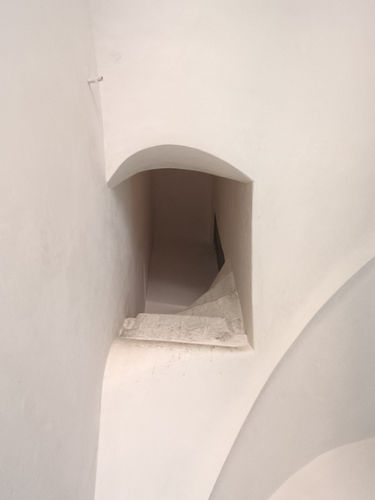
The Northwest Tower
AUDIO GUIDE(choose your language)
Dear visitor, welcome to the northwest tower.
The tower is a parallelepiped body with a rhomboidal base; it rests on a high truncated-pyramidal plinth with strongly splayed faces.
Its wall structure is made up of small ashlars arranged in parallel rows.
Probably, in its first installation, the tower certainly had to be isolated from the rest of the fortress.
You will be able to notice these construction elements as soon as you are outside the Castle, walking to the end of via Terravecchia in the old medieval village.
By climbing the stairs that lead you to the wooden mezzanine you will be able to admire the village below from a window. It is a mullioned window with arches in the center with the Abbate coat of arms. The mullioned window is placed at a height between the floor of the second floor room and the roof of the tower.
Here the vault is cross vaulted with plumes ending in Billiemi stone.
Returning to the floor below, through the small door, characterized by a pointed arch, you exit onto a small terrace, recently created, which allows you to observe the panorama of the city.
I invite you to go out onto the terrace and enjoy the show!
Looking up towards the battlements, you notice the brackets, which fit firmly into the masonry, connected to each other by monolithic rectangular slabs on which three rows of ashlars of different cuts and heights are placed.
The only decorative element is represented by five-petalled sculpted rosettes, placed at the top of the parapet, on the connecting plates and on the internal faces of the brackets.
The flat frames created at the edges of the plates connecting the shelves underline this decorative motif.
Another decorative element is the acanthus leaf created in low relief in the four corner shelves; on these there are four battlements with the typical hook shape.
Between the brackets there are the classic machicolations placed to defend the tower.
If you look towards the extrados of the first shelf on the left, you can notice a decorative detail: a hand carved on the shelf.
The hand, apparently female, is open and with the back facing outwards.
It is not clear what meaning this detail has. Its symbolic representation could bring back the popular legend according to which Baroness Laura, mortally wounded, left the imprint of her bloody hand on the wall of her room.
A hypothesis which cannot naturally be considered valid as the bloody event dates back to 1563 while the period of construction of the tower is much earlier. Unless some parts of the tower were remodeled after that date, in which case the legend becomes reality.
It could probably be a symbol of luck linked to an Arab workforce such as the hand of Fatima or, more likely, the signature of the workforce who decorated the battlements of the tower.
I now invite you to continue the visit and reach, via the walkway immediately in front of the entrance to the tower's access room, the room of the crime of the Baroness of Carini.


















